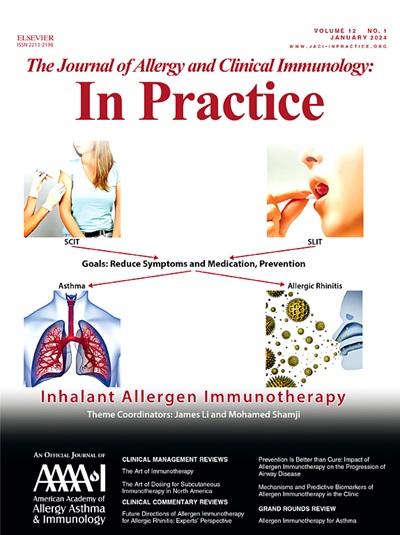Walnut Threshold Dose Distribution and Safe Dose in Allergic Patients (Nut CRACKER Study)
IF 6.6
1区 医学
Q1 ALLERGY
Journal of Allergy and Clinical Immunology-In Practice
Pub Date : 2025-09-01
DOI:10.1016/j.jaip.2025.05.041
引用次数: 0
Abstract
Background
Walnut is a significant global food allergen, but data relating to population reaction thresholds are limited. This hampers the ability of industry and regulators to undertake allergen risk assessment, increases use of allergen labeling, and impairs patients’ quality of life.
Objective
To describe reaction eliciting doses (EDs) in a large walnut-allergic population.
Methods
A retrospective cohort study including all reactive walnut oral food challenges (OFCs) was performed between July 2014 and May 2023 at Shamir Medical Center. OFCs were performed for either diagnostic reasons or at the beginning of oral immunotherapy. Objective signs were used as stopping criteria. Confirmatory safe-dose OFCs with dose intervals of 90 minutes or more were also analyzed.
Results
Overall, 415 walnut OFCs were analyzed, with no left- or right-censored data. Corresponding estimated ED01 and ED05 (amount of protein eliciting an objective reaction in 1% and 5% of the walnut-allergic population, respectively) were 0.8 mg (range, 0.3-24) and 3.8 mg (range, 1.1-96.4) for discrete and 1.2 mg (range, 0.4-29.4) and 5.9 mg (range, 1.7-140.5) for cumulative dosing. Doses less than or equal to 1 mg elicited subjective reactions (in 12.5% of patients), but no objective reactions during the 295 safe-dose OFCs performed. Factors associated with a lower reaction threshold to walnut included a younger age, oral immunotherapy-OFC protocol, and coallergy to pecan (P < .001 for all).
Conclusions
This is the largest published data set to inform EDs to walnut, with greater certainty of ED with the inclusion of safe-dose OFCs. These data address an evidence gap in the global Codex efforts to improve evidence-based allergen risk assessment for walnut.
过敏患者的核桃阈剂量分布和安全剂量(坚果钳研究)。
背景:核桃是全球重要的食物过敏原,但有关人群反应阈值的数据有限。这阻碍了行业和监管机构进行过敏原风险评估的能力,增加了过敏原标签的使用,并损害了患者的生活质量。方法:回顾性队列研究,包括2014年7月至2023年5月在Shamir医疗中心进行的所有反应性核桃口服食物刺激(OFCs)。由于诊断原因或在口服免疫治疗(OIT)开始时进行OFCs。客观体征作为停止标准。还分析了剂量间隔≥90分钟的验证性安全剂量OFCs。结果:总共分析了415个核桃OFCs,没有左或右删节数据。相应的估计ED01和ED05(分别在1%和5%的核桃过敏人群中引起客观反应的蛋白质量)分别为0.8 mg(范围0.3-24)和3.8 mg(范围1.1-96.4),累积剂量为1.2 mg(范围0.4-29.4)和5.9 mg(范围1.7-140.5)。剂量≤1mg引起主观反应(12.5%的患者),但在进行295次安全剂量ofc期间没有客观反应。与较低的核桃反应阈值相关的因素包括年龄较小、OIT-OFC方案和对山核桃的共同过敏(结论:这是公布的最大的关于核桃引发剂量的数据集,包含安全剂量的ofc后,引发剂量的确定性更大。这些数据弥补了全球食品法典委员会在改进基于证据的核桃过敏原风险评估方面的证据缺口。
本文章由计算机程序翻译,如有差异,请以英文原文为准。
求助全文
约1分钟内获得全文
求助全文
来源期刊

Journal of Allergy and Clinical Immunology-In Practice
ALLERGYIMMUNOLOGY-IMMUNOLOGY
CiteScore
11.10
自引率
9.60%
发文量
683
审稿时长
50 days
期刊介绍:
JACI: In Practice is an official publication of the American Academy of Allergy, Asthma & Immunology (AAAAI). It is a companion title to The Journal of Allergy and Clinical Immunology, and it aims to provide timely clinical papers, case reports, and management recommendations to clinical allergists and other physicians dealing with allergic and immunologic diseases in their practice. The mission of JACI: In Practice is to offer valid and impactful information that supports evidence-based clinical decisions in the diagnosis and management of asthma, allergies, immunologic conditions, and related diseases.
This journal publishes articles on various conditions treated by allergist-immunologists, including food allergy, respiratory disorders (such as asthma, rhinitis, nasal polyps, sinusitis, cough, ABPA, and hypersensitivity pneumonitis), drug allergy, insect sting allergy, anaphylaxis, dermatologic disorders (such as atopic dermatitis, contact dermatitis, urticaria, angioedema, and HAE), immunodeficiency, autoinflammatory syndromes, eosinophilic disorders, and mast cell disorders.
The focus of the journal is on providing cutting-edge clinical information that practitioners can use in their everyday practice or to acquire new knowledge and skills for the benefit of their patients. However, mechanistic or translational studies without immediate or near future clinical relevance, as well as animal studies, are not within the scope of the journal.
 求助内容:
求助内容: 应助结果提醒方式:
应助结果提醒方式:


